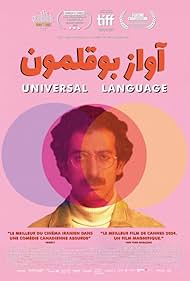These Eyes Written by Randy Bachman and Burton Cummings Performed by The Guess Who
Story
The absurdist triptych of seemingly unrelated stories finds a mysterious intersection in this story set somewhere between Winnipeg and Tehran.. Canada’s official submission for the ‘Best International Feature Film’ category at the 97th Academy Awards in 2025. From its cinematography and its usual search for symmetry, static or in traveling shots, and a pleasant aesthetic with a dreamy atmosphere that enhances the universality of the setting, to its story revolving around various characters, how their lives intersect and bring to life dialogue sometimes polite, other times not so much, the influence of Wes Anderson cuts through Matthew Rankin’s characterizations from beginning to end.
A freelance tour guide with strange choices for his tour, etc
As in Anderson’s films, Rankin is interested in exploring the reality of his film, a reality full of idiosyncrasies that serve as fertile ground for comedy. An angry teacher in a classroom yelling at students, one of whom claims a turkey stole his glasses; another dressed as Groucho Marx because he wants to be a comedian; and another as a fashionista. With a comedy consisting of ironic, deadpan and black humor, Une langue universelle manages to be funny whenever it wants to be.
Rankin’s dexterity manages to evoke a surreal dreamlike fable, but also an expressive introspective melancholy
There are many moments when its events border on absurdism or surrealism, enhancing the comedy that bathes it, but never undermining its goal of thought-provoking depth. Elements and feelings that merge and give life to a special experience between places and times, realities and dreams. For example, in the reality of the film, even though we are in Canada, French, let alone English, seems like a second language, and in its place there is Persian.
The camera is sometimes static from a distance, observing their movement and how it affects the surroundings, rather than focusing on their faces and expressions in close-ups
Everyone speaks it and signs and billboards are written in it, presenting its result as something close but distant, familiar and unfamiliar mixed in a culturally and demographically blind new reality. In terms of cinematography, which in many ways resembles Anderson’s, more in framing and movement than in color palette, there is a constant will to inhabit the spaces in which the characters find themselves. It is as if the place is as important as the characters to the telling of the story, and Rankin wants to make sure we immerse ourselves in it like tourists from a foreign land.








